Dr. Clowes and the Science of Art
Roxane Sperber
Clowes Associate Conservator of Paintings
Indianapolis Museum of Art at Newfields
INTRODUCTION
Dr. George Henry Alexander Clowes (1877–1958) built his art collection during a period of a great scientific advancement (fig. 1). A biomedical research chemist, Clowes was deeply involved in advancing medical science but also took a keen interest in the scientific study of art. In the early twentieth century, the field of conservation science was taking shape. Scientists began analyzing artist materials, investigating the degradation of objects, and experimenting with the effects of surrounding environmental conditions on collections. Authentication of artworks was also becoming more technically driven, and the work of art restorers, historically carried out by artists and craftsman, was professionalizing into the more scientifically anchored field of art conservation.1
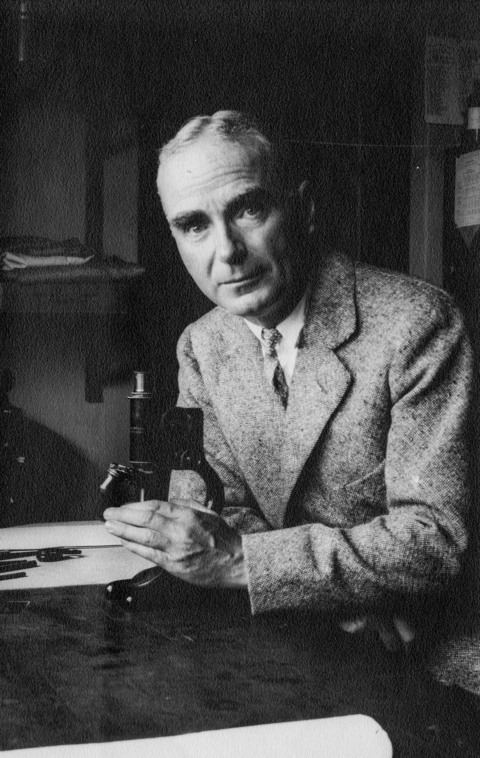
It is unclear how thoroughly Clowes engaged with the growing body of published research documenting the findings of such studies. However, his personal correspondence with restorers and dealers is filled with hypotheses, many surprisingly ahead of their time, which reveal that close observation of his collection came naturally to his curious mind.2 His scientific intuition served as a rudder for his relationship to the care and study of his collection.3
DEVELOPMENTS IN THE FIELD
In 1933, the year Clowes purchased his first painting, exciting developments in conservation science were under way around the globe. In the late nineteenth century, the first science lab devoted to the study of artwork was established at the Royal Museums of Berlin in Germany.4 By the 1920s, several French labs had also been established.5 The renowned Department of Technical Research at the Fogg Museum at Harvard was founded in 1928 by museum director Edward Forbes. Chemist Rutherford J. Gettens and art historian George L. Stout collaborated on much of the early research at the Fogg.6 From 1932 to 1942, their research, along with other early studies, was published in Technical Studies in the Field of the Fine Arts, the first academic journal dedicated to this subject.7 Clowes was a longtime benefactor of the Fogg, suggesting he was at least peripherally aware of the research going on there.8 In 1934, the same year Clowes acquired it, the School of Fra Angelico Nativity panel was examined and imaged by Fogg staff.9 Clowes later wrote that any “treatment in the Fogg would have been made with a purely scientific objective."10
Other laboratories made in the image of the Fogg began springing up around the world. In 1930, the Chemical Conservation Laboratory at the Madras Government Museum in Chennai, India, was established under the leadership of Dr. S. Paramasivan.11 In London, a department dedicated to conservation and technology was part of Viscount Lee of Fareham’s founding vision for the Courtauld Institute of Art. The Courtauld lab opened in 1934 under the leadership of organic chemist P.D. Ritchie, who was appointed head of the scientific department and laboratory, and research and technical advisor Daniel V. Thompson Jr., who had trained at the Fogg.12
From the 1920s, increased numbers of PhD degrees were undertaken in the analysis of artist materials13 and the International Conference for the Study of Scientific Methods in the Examination and Conservation of Artworks—the first of its kind—was held in Rome in 1930. Stout later reflected that this event occurred,
… at or near the end of an indefinitely long period of complacency with respect to the conservation of works of art. The central personages for generations had been the restorers, occasionally named artist-restorers. Most of them had gone through some kind of standard preparation in an academic art school….A few manuals, more or less explicit as to directions for repair, had been printed over a hundred-year stretch….By 1930 there was a vocal disquiet about this; it was not good enough.14
Three years later, a second conference dedicated to this topic was held in Paris, fueling growth in the field.
THE RESTORERS AND THEIR WORK
Throughout the 1940s and 1950s Clowes corresponded directly with three restorers who worked on his collection—Roman Caesar Diorio, Ludwig Furst, and William Suhr. Anthony Riportella and Edward O. Korany also treated works in the Clowes Collection, but correspondence with these men went primarily through Clowes’s dealers. Many of these men identified themselves as both artists and restorers. However, in their letters to Clowes, their technical knowledge and increasingly scientific approach to their work is abundantly evident.
Like Clowes, the restorers who worked on his collection were all foreign born, and all but Suhr were immigrants to the United States. While Suhr was born in Germany, he is listed on a 1940 census as an American citizen born abroad because his mother had been born in the United States.15 A naturalization petition for Diorio lists Rome, Italy, as his birthplace (fig. 2). Diorio appears to have immigrated in 1933 to New York, where he worked as an “artist & restorer of paintings."16 Riportella was also born in Italy and is listed as “artist” on a 1915 census of New York City.17
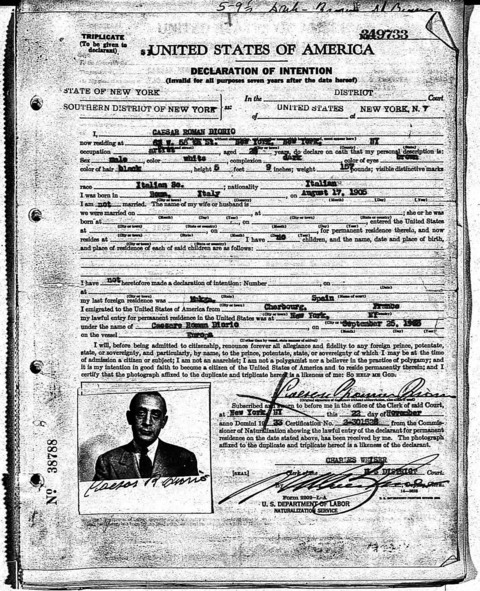
Furst and Korany both hailed from Vienna, Austria, and listed their race as “Hebrew” on their US naturalization petitions.18 Given that both men were Jewish, they were likely fleeing Nazi occupation of Austria, which began in 1938. Although little is known about their personal stories, the timing of their escape from Europe tells a harrowing tale.
According to dealer Bertram Newhouse, Korany worked in “one of the great museums in Europe,"19 perhaps the Kunsthistorisches Museum in Vienna, but immigrated to New York in October of 1939.20 It is possible that Korany left Austria during the forced emigration of Jews that began in the spring of 1938 and which, by the spring of 1939, had removed 50 percent of Austria’s Jewish population.21 His last European residence was in Prague, but the Nazi occupation of Czechoslovakia in May of 1939 may have prompted him to leave Europe permanently. Korany worked primarily in New York but restored paintings for the St. Louis Art Museum as well as other U.S. museums.22 He appears to have also worked for the Ringling Museum of Art in Sarasota, Florida, perhaps relocating later in his career.23 Furst resided in Vienna during the Nazi occupation, leaving only in January of 1940, shortly before the widespread deportations of Jews to concentration camps began.
William Suhr was the most well-known restorer to work on the collection during Clowes’s lifetime. Suhr came to the United States in 1927 at the request of Wilhelm Valentiner, the director of the Detroit Institute of Arts who had worked with Suhr in Berlin (fig. 3). Highly sought-after, Suhr established himself in both Detroit and New York, seemingly doing several jobs at once. In a 1977 interview, he recalled that his “services were called for by every museum in the Middle West,” in addition to private collectors such as Albert Barnes and Clowes. From 1935 he negotiated an arrangement with the Arts Commission in Detroit whereby he spent only one month out of the year there, spending the rest in New York as the “permanent restorer” at the Frick. There, Director Mortimer Clapped offered him the “freedom to accept any outside work he pleased” (fig. 4).24
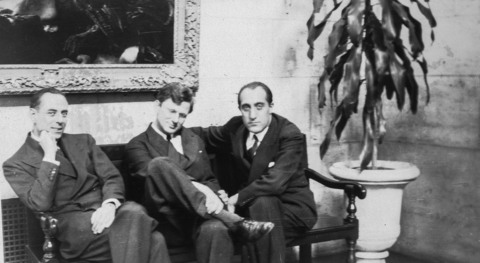
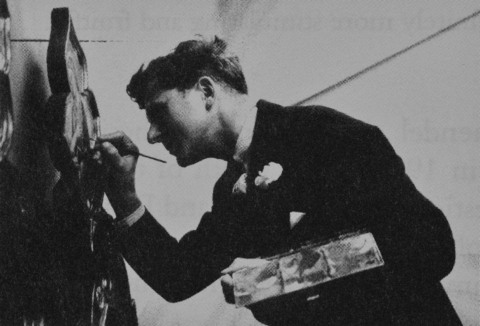
Well-connected in the conservation world, Suhr served alongside George Stout and Edward Forbes on a committee that outlined terminology and standards for museum records of the condition and conservation of works of art.25 He also published in the first edition of the journal Technical Studies in the Field of the Fine Arts.26 Barnes called Suhr “the best restorer in the world."27 This sentiment was echoed by the art dealer Bertram Newhouse in a letter to Clowes, in which he described Korany as “one of the great restorers of Europe…on a par with Mr. William Suhr."28
Clowes regarded Suhr as a fellow scientist. Challenging Newhouse’s advice not to clean his newly acquired Ribera, Clowes suggested that Suhr be consulted as he “might feel that he could at least try a cautious experiment to find out what could be done."29 In his reply, Newhouse seemed agitated and put the matter to rest by emphatically assuring Clowes,
The picture was cleaned some short while ago by the man who does the conservation work for the paintings in the Liechtenstein Collection…. [He] is considered to be one of the outstanding conservators and restorers of Europe. He has a reputation for undercleaning rather than overcleaning, and I believe that certainly this is the wiser and better procedure than attempting to go too far with the painting.30
Suhr did, however, treat at least two work in Clowes’s collection, the Workshop of Titian Portrait of Andrea de’ Franceschi in 1955 and the attributed to Leandro Bassano Portrait of a Man in 1956. Clowes corresponded directly with him about these treatments. On at least one occasion, Suhr visited Westerley, Clowes’s Indianapolis home, to see the “pictures and check up on their condition."31
Clowes’s respect for scientific expertise extended to Diorio as well. “I look upon you as a scientific and artistic expert,” 32 he wrote to Diorio, “I appreciate very greatly the work that you have done…and shall be glad to give you further business in the future."33 Diorio, in turn, appreciated Clowes’s curiosity about art and the process of restoration, writing, “you are a scientist and a student of art…. I feel most obligated to keep you informed of every detail that may be useful to you."34
Clowes held Furst in equally high esteem. In a dispute in which Mrs. Ball of Muncie took legal action against Furst to avoid paying a bill, Clowes intervened. Drawing a parallel to the field of medicine, he explained that Furst’s “caliber in the profession was entitled to a higher rate than the average, just as a good surgeon would be entitled to a higher rate than an average surgeon."35
Clowes’s appreciation for the unique expertise of restorers did not, however, make them immune to his demands and occasional impatience. Diorio began nearly every letter with a plea for forgiveness for his tardiness in writing and was reprimanded by Clowes on several occasions. Unhappy with the results of some of Diorio’s X-radiography, Clowes bluntly stated that some would have to be repeated, and he would therefore be lowering Diorio’s compensation to reflect the quality of the work.36 When Korany was late delivering the treatments on the El Greco Apostolados, Newhouse wrote exasperatedly to Clowes explaining, “The man who is doing it can’t be hurried. If one attempts to hurry him it makes it all the worse and nothing is accomplished."37
Clowes, however, was unfazed by this delay, responding, “it certainly would be a shame if, by hurrying the work, we were to wind up with a defective coat of varnish."38 Indeed, he repeatedly cautioned his restorers against rushing. “I do not want you to in any way hurry this picture,” he wrote to Diorio, “I know how difficult such work is, and I feel that the success of this work may depend on your not doing it when you are not in the mood."39 A few months later, he reiterated, “you should not attempt to rush things when you are tired or disinclined to work."40 These remarks, from an otherwise exacting personality, express a remarkable understanding for the delicate mental state required to conserve a work of art.
IMAGING AND TECHNICAL STUDY
The use of technical imaging to study art was first implemented in the early twentieth century and is still widely used today. X-radiography was invented in 1896 and found use in the examination of works of art shortly thereafter.41 Ultraviolet-induced visible fluorescence was used to examine art from the 1920s, and the ability of infrared photography to see below the surface of a paint layer was noted in the 1930s.
Always a man of science, Clowes was proactive about obtaining technical imaging of his collection. In two letters from 1949, Furst mentions carrying out “x-rays, infrared photos, and ultraviolet examination” on Clowes’s paintings.42 In another letter, Clowes expressed his disappointment that a short timeframe with a Van Dyck painting did not allow “the possibility of studying it with x-rays, infrared, ultraviolet, etc.,” which he clearly saw as an integral part of assessing the work.43
However, it is unclear exactly where this analysis was performed. Today, such analysis is primarily carried out in the conservation labs of large institutions. Clowes had X-radiographs taken at museums (including the Fogg and Brooklyn Museum), but his restorers also appear to have taken and developed X-radiographs themselves.44 In a letter to Diorio, Clowes mentions that some X-radiographs were taken in Indianapolis, but Diorio developed them in his darkroom in New York.45 In a rather contentious back and forth, Diorio explained that his delay getting the images to Clowes was due to trouble with his darkroom and he therefore needed to develop the plates at General Electric.46
Clowes emphasized the importance of X-radiographs in assessing condition. “X-rays and [a] statement from Mr. Kech, of the Brooklyn Museum” were conditions of purchase for the Madonna and Child by Giulio Francia, which Clowes obtained from art dealer John H. Folman in 1954.47 Although misspelled, “Mr. Kech” is almost certainly Sheldon Keck, who founded the conservation lab at the Brooklyn Museum and worked there from 1934 to 1961 (fig. 5).48 A giant in the field, Keck was the first academically trained conservator in the United States and served with the “Monuments Men” during World War II alongside Stout and others.49 He was later the first director of the Conservation Center at the Institute of Fine Arts at New York University and founded the Cooperstown Conservation training program, now housed at SUNY Buffalo.50
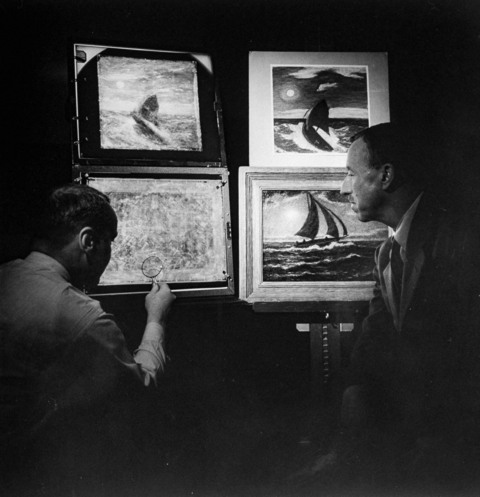
Clowes also understood the importance of noninvasive imaging in assessing a course of treatment. He suggested Diorio take an X-radiograph of the Luini Madonna and Child with St. John the Baptist and the Lamb to determine if it had been “extensively repainted or…suffered a heavy loss."51 Several weeks later, he reiterated his desire and proposed that Diorio,
First make x-rays and check up on it carefully and then clean some small corner…because if the whole thing is very thin and dependent in considerable measure for its effect on what is left of the surface glaze, it is quite possible that if you use a strong solvent and take off all the upper layers of varnish, etc., you will lose in the end.52
While Diorio could be forgiven for finding Clowes’s enthusiasm a bit overbearing, the methodical, scientifically informed approach he describes is precisely how conservators approach treatment.
Clowes appears to have occasionally had works analyzed by more sophisticated methods. In one letter, Diorio mentions working with Dr. Colin G. Fink at Columbia University to analyze samples using “chemical analysis."53 Fink was a chemist who appears to have taken an interest in issues of art restoration and conservation science. Clowes’s restorers were also referencing a growing body of literature related to the technical study of works of art. In a letter to Newhouse, later forwarded to Clowes, Korany stated that he believed a work titled Magnificat by Giovanni di Paolo to be carried out in pure egg yolk with a “boiled varnish medium” used in the glazes.54 Korany commented that the painting followed the rules of Cennino Cennini’s fifteenth-century Italian workshop, suggesting he was reading Daniel Thompson’s translation of The Craftsman’s Handbook (Il libro dell’arte), which was first published in 1933 and is still referenced by conservators today.55
Clowes’s enthusiasm for technical study was bolstered by a two-decade long saga involving the Follower of Rembrandt Man with a Fur-Trimmed Hat. His evolving opinion of the mysterious little painting was influenced by its changing condition. Originally purchased from Newhouse in 1934 (fig. 6), he sold the panel to dealer Ivan Podgoursky about a decade later after deciding it was of lesser quality than he originally thought.56 In 1952, Newhouse alerted him that the painting had been cleaned in Switzerland and indeed had been badly overpainted. Reflecting on his decision to sell it, Clowes remarked that, even if the picture was badly overpainted, he had been “inclined to feel that the parts that were still good did not measure up to Rembrandt but might very well be the work of one of his most distinguished pupils.” As his letter continued, however, Clowes’s regret at the misstep became clear, telling Newhouse, “You and I were at fault in failing to carry out some careful experimental work to determine the true nature of the picture…we should be careful that nothing of this sort ever happens to us again."57
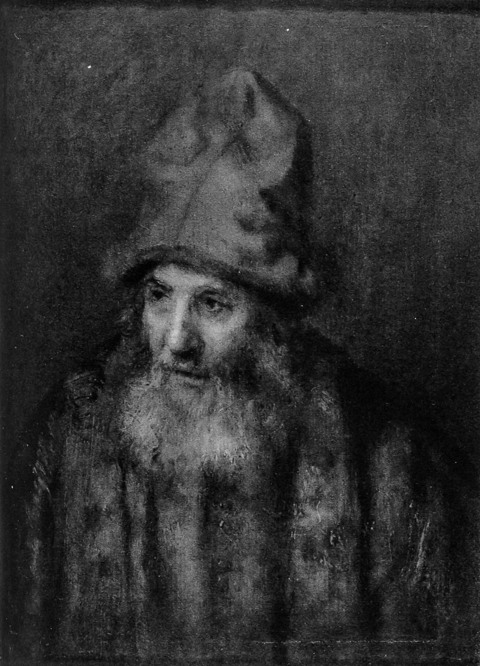
The results of the conservation treatment so impressed Clowes that he remedied his error by repurchasing the painting in 1955. There is “vastly greater certainty that it is by Rembrandt than was the case when it was still…partially repainted,” he wrote enthusiastically.58 The attribution of this painting remained a mystery until, in preparation for this catalogue, modern analytical techniques, including X-ray fluorescence spectroscopy (XRF) and dendrochronology, suggested that the painting was, as Clowes originally surmised, by one of Rembrandt’s close pupils.
TREATMENT
In correspondence with his restorers, Clowes enjoyed discussing the minute details of treatments, and while in traveling to New York City, he frequently visited the restorers' studios to observe their work.59 On at least one occasion, Newhouse arranged to have paintings that were undergoing treatment brought to Easterly, Clowes’s home in Woods Hole, Massachusetts, for him to study.60
Clowes generally respected the recommendations of his restorers, but his instincts for working methodically and preference for minimal intervention were ahead of his time. While this approach is now widely embraced by conservators, more invasive interventions were common during the mid-twentieth century. Suhr appears to have, at least in theory, shared Clowes’s cautious approach, stating that he was “of the opinion that paintings, like humans, should be left alone as long as possible."61
In his correspondence with Diorio, Clowes wrote, “I am confident that I can bank on you not to clean the picture too much. If in doubt, I should certainly prefer to leave some of the over-painting, rather than reduce the picture to the state of some of those that I recently saw in the Kress collection."62 Later he reiterated, “I hope you will clean it with extreme caution and not use too much solvent on the surface, as I am inclined to believe that the picture is somewhat worn down and thin and we ought not to risk losing even the smallest trace of what is left of the original."63
Clowes first observed the Agnolo Gaddi panels St. Mary Magdalene, St. Benedict, St. Bernard of Clairvaux and St. Catherine of Alexandria when they were in the possession of Podgoursky in the 1940s. He was disturbed by what he perceived as “rather extensive areas of restoration” and suggested Podgoursky consult Richard Offner, a medieval art specialist, for his opinion.64 The panels, which had severe blistering, were later treated by Korany, who initially suggested the works be transferred to a new support. In this case, there is no evidence that Clowes advocated against the transfer, but thankfully, efforts to consolidate the paint layers without destroying the original support were successful.65
Clowes sometimes dictated the materials used in treatment as well, stressing that Diorio “use tempora [sic] instead of oil…as there is no doubt that if you use oil it will show up very soon."66 Clowes was aware of discoloration of restoration on paintings at the John Herron Art Institute and was deeply concerned about it. It is unclear from his letter if he observed the discoloration himself or was made aware of it by his friend Wilbur D. Peat, the Institute’s director.
Nevertheless, Diorio seized the opportunity to brandish his knowledge and teach the doctor a lesson:
Regarding your warning about the medium to be employed in restoration I would like to say a few words enlightening [you] about [a] few things you may not know….First you must know that every restorer in the world is using almost the same kind of medium for restoretion [sic] This medium is neither oil or strictly tempera, although they may call it so. The vehicle commonly used is a very light type of varnish that comes on the market under various trade names as Damar varnish, restoring varnish, etc. The oil as a medium in restoration has been discarded for, at least, fourty [sic] years because of it’s [sic] quick alteration in color and transparency. The real tempera is impractical for various reasons (at least commercially). In our case (Bellini) the major damaged parts are the Cherubins [sic]; those were refilled with a pure tempera and then fixed with a fixative. With this medium I do not think you should worry about any change in color.67
While clearly uninformed about modern practice, Clowes was right to voice concern about the use of oil. In addition to quickly discoloring, oil restoration is difficult to remove from oil paintings without damaging the original surface due to the similarities in solubility of the original medium and the restoration.
Clowes also articulated his trepidation about the treatment process, writing to Podgoursky, “about this question of taking several layers of old varnish off anything so delicately and so thinly painted as the Bosch my principal concern is whether, even with the greatest care and pains, it will be possible for Mr. Furst…to leave the original in such a form that after revarnishing it will appear much more brilliant than is the case at present."68 On other occasions he offered his own detailed assessment of what the treatment should entail:
The entire picture, including the background, should be carefully cleaned and reglazed, particularly the face and hands, which have lost some surface material but are really still in very excellent condition. I am most anxious to get away from the extreme pallor of the face, which is due, I feel, in part to loss of glaze and possibly also to some extent due to a small amount of disintegration in the crackle.69
Despite Clowes’s thorough assessment, Furst replied that, without seeing the work himself, he could not offer an opinion on what should be done.70
Generally, however, Clowes’s restorers acquiesced in his desire to be kept abreast of every step of the process. During his treatment of the Giovanni Bellini and Workshop Madonna and Child with St. John the Baptist, Diorio sent Clowes detailed photographs that were “marked to show where each damage was restored, and with what medium."71 When Clowes pressed him to take some artistic liberties in the restoration, Diorio refused: “If such a problem had arisen with a work belonging to someone other then [sic] yourself, I may not have hesitated…to please that owner at the expense of the painting. This, however, is not the case."72 While his flexible approach does not reflect terribly well on Diorio’s practice, the carefully observed description of the artist’s technique and detail-oriented approach to treatment outlined in the letter displays an impressive knowledge of both the art and science of restoration.
ENVIRONMENTAL CONDITIONS
Clowes was especially forward-looking when it came to regulating the environmental conditions surrounding his collection. His awareness of the discolored retouching on paintings at the Herron Art Institute, as well as an incident in which he perceived fading on an important document at the Royal Society in London, appears to have sparked Clowes’s concern about the environment surrounding his collection.
In response to his concern, Diorio explained, “There is no restoretion [sic] or fresh paintings that can stand the ultra violet [sic] of the sun, day after day."73 Interestingly, a letter dated 5 July 1932 from John S. Wright, an Eli Lilly and Company executive, to Peat, the director of the Herron Art Institute, shares a copy of an article published in the Journal of Pharmacy on the fading of modern artists' materials. While it is unclear how closely Wright and Clowes worked together, or if they knew each other at all, Clowes certainly knew Peat. This connection suggests that the scientists at Lilly were aware of, and interested in, research into the fading of art materials and that Peat was consulting with them about changes to the works he stewarded.
In the spring of 1951, shortly after acquiring the Rembrandt Self-Portrait, Clowes wrote to Newhouse about the lighting on the painting: “This is a matter about which I have always been greatly concerned. I have seen serious damage done to valuable documents by exposure to too hot a light and am always uneasy about a picture, especially if it is on a wooden panel.” He was particularly concerned as there was “a slight warping or wave, which is most pronounced at the top of the picture, and I certainly have no intention of risking anything that might make this condition worse.” He had, apparently, already done some research about mitigating this effect and told Newhouse he would be ordering nonreflecting glass, which was only newly available.74
While the first mention of microclimate enclosures for paintings dates to 1892, it was not until the 1960s that extensive interest in this area of research developed in the conservation field, putting Clowes, in the early 1950s, ahead of many conservators and conservation scientists.75 In his reply, Newhouse assured Clowes that “the care of these pictures is something in which I desire to cooperate with you in every way.” He offered to come to Indianapolis with his electrician Benny to “experiment with the lighting until it is to your complete satisfaction."76 True to his word, the cost of this visit was fully covered by Newhouse.77
In assessing a severe flaking problem on the Workshop of Titian Portrait of Andrea de’ Franceschi painting, Suhr recommended a “radical” intervention that would include a complete canvas transfer, in which the original canvas was scraped off from the back, leaving only the ground and paint layer.78 The work would then be adhered to a new canvas. Clowes, in contrast, looked to the environment around the painting to explain the condition. “Since the picture has been over the mantelpiece in our study and since fires are occasionally lighted, I am wondering whether it is possible that temperature changes in the chimney or any heat rising from the fireplace could have anything to do with the tendency of the paint to be detached from the canvas” (fig. 7).79 Clowes seems to have elected a less-intrusive approach to treatment than originally proposed by Suhr. The original canvas was, thankfully, retained, and adhesive was introduced locally under areas of flaking paint.80
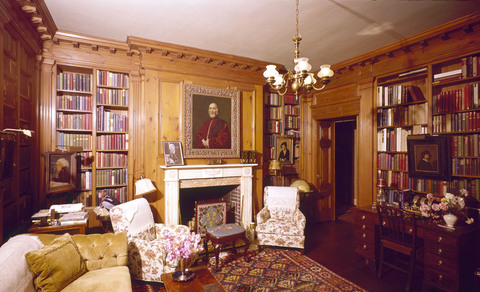
It is unclear if he moved the painting, but subsequent condition assessments do not record significant issues with flaking. Indeed, since coming to the IMA in 1972, where strict environmental controls are implemented, the painting has not exhibited any flaking, suggesting Clowes’s suspicion that abrupt changes in temperature and humidity were responsible for the damage. The impact of preventative conservation, which advocates for stable environmental conditions, on the profession cannot be overstated. Conservation pioneer Harold Plenderleith commented in 1978 that when paintings were moved from the National Gallery in London to a slate quarry in Wales during World War II, they greatly benefited from the stable relative humidity and temperature in the quarry—so much so that “restorers were out of a job."81 In the postwar era, such lessons were being implemented at museums around the world.
When faced with blooming varnish on his El Greco paintings (fig. 8), Clowes hypothesized that the “coat of varnish that was applied at a period of extreme heat and very high degree of moisture” caused the cloudy appearance.82 Some years later, upon return from a series of exhibitions, Clowes observed blooming in the varnish of the Rembrandt Self-Portrait. This time, he hypothesized that the cloudiness was due to “exposure to variation in temperature."83 Regardless of the precise cause, he was certainly correct to attribute these changes to the painting’s surroundings.
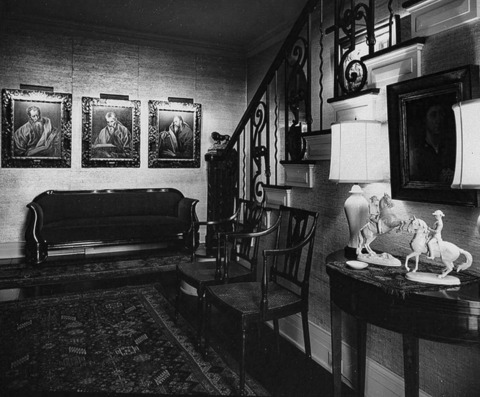
It is not impossible that Clowes was reading expert advice about how best to care for his collection. The effects of pollution, light, and heat on paintings began to be noted in England in the mid-nineteenth century, and the effects of central heating on collections—an exaggerated dryness when the air is warmed without humidification—was observed almost immediately.84 As early as the 1920s, Forbes was pushing preventative conservation measures, encouraging collectors to consider factors like temperature, relative humidity, noxious gases, dirt, insects, and physical injuries when caring for their collections.85 By the 1950s, the effects of lighting on works of art was also being widely studied.86
As a scientist, Clowes was attuned to the importance of preventative conservation even before his restorers. His insistence on limiting light levels, monitoring environmental conditions, and glazing his paintings are uncannily appropriate recommendations even by today’s standards. In fact, preparations for the reinstallation of the Clowes Collection in 2022 focused largely on glazing vulnerable works and carefully studying lighting conditions to maintain a safe environment.
CONCLUSION
This catalogue honors Clowes’s fascination with the science of art by including extensive technical entries with comprehensive imaging of each painting. Many of these imaging techniques were first used on the collection by restorers at Clowes’s direction, but the more advanced analytical techniques available today allow us to investigate aspects of the collection that Clowes could only have dreamed of.
We hope by making this data widely available that scholars can continue to answer questions about these paintings that were first raised by Clowes himself. We also wish to shed some light on the restorers who cared for the collection, some of whom have been all but lost to history. While their approaches to their work is certainly reflective of their time, they clearly endeavored to do their best to protect these works of art. At a time when the understanding of the science of art and how best to care for collections was rapidly evolving, Clowes’s intuition about his collection portended what was to come.
Notes
-
The terminology used for the profession we now call art conservation was in flux during this period. As the field of art conservation developed, the differences between conservation and restoration became more defined. During the mid-twentieth century, academically trained conservators sometimes referred to themselves as such, but they were few and far between, and the more commonly used term was “restorer.” Because most of the people who worked for Clowes self-identified as restorers, this term has been used to refer to them and their work. ↩︎
-
In tribute to Clowes’s interest in the technical aspects of art works, this catalogue has devoted significant effort to thoroughly investigating the Clowes Collection using cutting-edge technologies. ↩︎
-
While Clowes collected paintings, works on paper, and objects, his correspondence discusses primarily his paintings collection. For this reason, this essay will focus primarily on paintings. ↩︎
-
Mark Gilberg, “Friedrich Rathgen: The Father of Modern Archaeological Conservation,” Journal of the American Institute for Conservation 26, no. 2 (1987): 105, https://doi.org/10.1179/019713687806027843. ↩︎
-
Fernand Mercier, a medievalist who was impressed by the potential of the scientific examination of works of art, established the Laboratoire microradiographique of the Musée des Beaux-Arts de Dijon, and an experimental laboratory at the Louvre, headed by physicist Jean Fernand Cellerier, was established in 1923. Marco Cardinali, “Technical Art History and the First Conference on the Scientific Analysis of Works of Art (Rome, 1930),” History of Humanities 2, no. 1 (2017): 227–229. ↩︎
-
Francesca G. Bewer, A Laboratory for Art: Harvard’s Fogg Museum and the Emergence of Conservation in America 1900–1950 (Cambridge, MA: Harvard Art Museum/New Haven: Yale University Press, 2010), 133–134. ↩︎
-
Joyce Hill Stoner, “Changing Approaches in Art Conservation: 1925 to the Present,” in Scientific Examination of Art
Modern Techniques in Conservation and Analysis (Washington, DC: The National Academies Press, 2005). ↩︎
-
Letter from G.H.A. Clowes to John Coolidge, 7 January 1957, Correspondence Files, Clowes Registration Archive, Indianapolis Museum of Art at Newfields. ↩︎
-
See Entry. Technical examination report from Harvard University Fogg Art Museum, 14 June 1934, File C10001, Clowes Registration Archive, Indianapolis Museum of Art at Newfields. ↩︎
-
Letter from G.H.A Clowes to Roman C. Diorio, 30 June 1941, Correspondence Files, Clowes Registration Archive, Indianapolis Museum of Art at Newfields. ↩︎
-
Sanchita Balachandran, “Transformative Spaces: Dr. S. Paramasivan and Conservation Science in India in the Early Twentieth Century,” Studies in Conservation 64, no. 1 (2019): 24, https://doi.org/10.1080/00393630.2018.1433002. ↩︎
-
Roxane Sperber and Aviva Burnstock, “A History of the Department of Conservation and Technology at the Courtauld Institute of Art,” Studies in Conservation (2021): https://doi.org/10.1080/00393630.2021.1966184. ↩︎
-
Jilleen Nadolny, “A History of Early Scientific Examination and Analysis of Painting Materials ca. 1780 to the Mid-Twentieth Century,” in Conservation of Easel Paintings, ed. Joyce Hill Stoner and Rebecca Rushfield (New York: Routledge, 2020), 339. ↩︎
-
George L. Stout, “Thirty Years of Conservation in the Arts: A Summary of Remarks to the I.I.C. American Group in New York, June 1963,” Studies in Conservation 9, no. 4 (1964): 126. ↩︎
-
1940 US Census, New York, NY, roll m-t0627-02657, 11B, enumeration district 31-1388. See also Joyce Hill Stoner, “The legacy of William Suhr: from Berlin to New York,” ICOM Committee for Conservation, ICOM-CC 14th Triennial Meeting, The Hague, 12–16 September 2005, Preprints (London: James & James, 2005), II:1040. ↩︎
-
While Diorio’s letterhead reads “Roman C. Diorio,” and he appears to have gone by Roman, his official documents list his name as Caesare Roman Diorio. Index to Petitions for Naturalizations Filed in Federal, State, and Local Courts in New York City, 1792–1906, 5700802, Records of District Courts of the United States, 1685–2009, RG 21, National Archives and Records Administration, Washington, DC. ↩︎
-
New York State Archives, Albany, NY, State Population Census Schedules, 1915. Election District 15, Assembly District 19, Kings County, New York, 67. ↩︎
-
The National Archives at Philadelphia, Philadelphia, PA, Declarations of Intention for Citizenship, 1/19/1842– 10/29/1959, 4713410, Records of District Courts of the United States, 1685–2009, 21.2009. ↩︎
-
Letter from Bertram Newhouse to G.H.A. Clowes, 21 December 1952, Correspondence Files, Clowes Registration Archive, Indianapolis Museum of Art at Newfields. ↩︎
-
The National Archives at Philadelphia, Philadelphia, PA, Declarations of Intention for Citizenship, 1/19/1842– 10/29/1959, 4713410, Records of District Courts of the United States, 1685–2009, 21.2009. ↩︎
-
Marilyn J. Harran et al., The Holocaust Chronicle (Sturtevant, WI: Publications International, Ltd., 2000), 122, http://www.holocaustchronicle.org/StaticPages/122.html. ↩︎
-
Letter from Bertram Newhouse to G.H.A. Clowes, 21 December 1952, Correspondence Files, Clowes Registration Archive, Indianapolis Museum of Art at Newfields. ↩︎
-
Klara Steinweg mentions Korany as the conservator at the Ringling Museum in the Acknowledgments section of Richard Offner and Klara Steinweg, ed., A Critical and Historical Corpus of Florentine Painting, sec. 4, vol. 4, The Fourteenth Century: Giovanni del Biondo (Part I) (New York: Institute of Fine Arts, New York University, 1967). ↩︎
-
Joyce Hill Stoner, “The Legacy of William Suhr: From Berlin to New York,” in ICOM Committee for Conservation, ICOM-CC 14th Triennial Meeting, The Hague, 12–16 September 2005, Preprints (London: James & James, 2005), II:1041. ↩︎
-
George L. Stout “A Museum Record of the Condition of Painting,” in Technical Studies in the Field of the Fine Arts, vol. 3 (1934; repr., New York: Garland Publishing, Inc., 1975), 200. ↩︎
-
William Suhr, “A Build-Up Panel for Blistered Paintings on Wood,” in Technical Studies in the Field of the Fine Arts, vol. 1 (1932; repr., New York: Garland Publishing, Inc., 1975), 29–34. ↩︎
-
Joyce Hill Stoner, “The Legacy of William Suhr: From Berlin to New York,” in ICOM Committee for Conservation, ICOM-CC 14th Triennial Meeting, The Hague, 12–16 September 2005, Preprints (London: James & James, 2005), II:1042. ↩︎
-
Letter from Bertram Newhouse to G.H.A. Clowes, 21 December 1952, Correspondence Files, Clowes Registration Archive, Indianapolis Museum of Art at Newfields. ↩︎
-
Letter from G.H.A. Clowes to Bertram Newhouse, 9 December 1955, Correspondence Files, Clowes Registration Archive, Indianapolis Museum of Art at Newfields. ↩︎
-
Letter from Bertram Newhouse to G.H.A. Clowes, 13 December 1955, Correspondence Files, Clowes Registration Archive, Indianapolis Museum of Art at Newfields. ↩︎
-
Letter from G.H.A. Clowes to Bertram Newhouse, 9 February 1956, Correspondence Files, Clowes Registration Archive, Indianapolis Museum of Art at Newfields. ↩︎
-
Letter from G.H.A. Clowes to Roman C. Diorio, 3 September 1941, Correspondence Files, Clowes Registration Archive, Indianapolis Museum of Art at Newfields. ↩︎
-
Letter from G.H.A. Clowes to Roman C. Diorio, 23 July 1941, Correspondence Files, Clowes Registration Archive, Indianapolis Museum of Art at Newfields. ↩︎
-
Letter from Roman C. Diorio to G.H.A Clowes, 19 October 1941, Correspondence Files, Clowes Registration Archive, Indianapolis Museum of Art at Newfields. ↩︎
-
Letter from G.H.A Clowes to Ludwig Furst, 12 December 1949, Correspondence Files, Clowes Registration Archive, Indianapolis Museum of Art at Newfields. ↩︎
-
Letter from G.H.A Clowes to Roman C. Diorio, 25 July 1941, Correspondence Files, Clowes Registration Archive, Indianapolis Museum of Art at Newfields. ↩︎
-
Letter from Bertram Newhouse to G.H.A. Clowes, 9 June 1952, Correspondence Files, Clowes Registration Archive, Indianapolis Museum of Art at Newfields. ↩︎
-
Letter from G.H.A. Clowes to Bertram Newhouse, 18 September 1952, Correspondence Files, Clowes Registration Archive, Indianapolis Museum of Art at Newfields. ↩︎
-
Letter from Roman C. Diorio to G.H.A Clowes, 30 June 1941, Correspondence Files, Clowes Registration Archive, Indianapolis Museum of Art at Newfields. ↩︎
-
Letter from G.H.A Clowes to Roman C. Diorio, 5 November 1941, Correspondence Files, Clowes Registration Archive, Indianapolis Museum of Art at Newfields. ↩︎
-
Rhona MacBeth, “The Technical Examination and Documentation of Easel Paintings,” in Conservation of Easel Paintings, ed. Joyce Hill Stoner and Rebecca Rushfield (New York: Routledge, 2012), 300. ↩︎
-
Letter from Ludwig Furst to G.H.A Clowes, 23 May 1949, Correspondence Files, Clowes Registration Archive, Indianapolis Museum of Art at Newfields. Letter from Ludwig Furst to G.H.A Clowes 28 November 1949, Correspondence Files, Clowes Registration Archive, Indianapolis Museum of Art at Newfields. ↩︎
-
Letter from G.H.A. Clowes to Clyde Newhouse, 6 December 1951, Correspondence Files, Clowes Registration Archive, Indianapolis Museum of Art at Newfields. ↩︎
-
Judicial notice in the case of George H.A. Clowes v. Jacob M. Heimann, 10 December 1947, Correspondence Files, Clowes Registration Archive, Indianapolis Museum of Art at Newfields. ↩︎
-
Letter from G.H.A Clowes to Roman C. Diorio, 30 June 1941, Correspondence Files, Clowes Registration Archive, Indianapolis Museum of Art at Newfields. ↩︎
-
Letter from Roman C. Diorio to G.H.A Clowes, 13 June 1941, Correspondence Files, Clowes Registration Archive, Indianapolis Museum of Art at Newfields. ↩︎
-
Agreement between G.H.A Clowes and John H. Folman, 19 November 1954, Correspondence Files, Clowes Registration Archive, Indianapolis Museum of Art at Newfields. ↩︎
-
William H. Honan, “Sheldon Keck, 83, Pioneer in the Field of Art Conservation,” New York Times, 17 June 1993. ↩︎
-
Brandon Schlager, “Preserving a Culture: The Untold Story of Buffalo State’s ‘Monuments Men’ (and women),” The Record, 26 February 2014, https://buffstaterecord.com/2765/culture/preserving-a-culture-the-untold-story-of-buffalo-states-monuments-men-and-women/. ↩︎
-
Francesca G. Bewer, A Laboratory for Art: Harvard’s Fogg Museum and the Emergence of Conservation in America 1900–1950 (Cambridge, MA: Harvard Art Museum/New Haven: Yale University Press, 2010), 175. See also William H. Honan, “Sheldon Keck, 83, Pioneer in the Field of Art Conservation,” New York Times, 17 June 1993. ↩︎
-
Letter from G.H.A Clowes to Roman C. Diorio, 1 August 1941, Correspondence Files, Clowes Registration Archive, Indianapolis Museum of Art at Newfields. ↩︎
-
Letter from G.H.A Clowes to Roman C. Diorio, 18 September 1941, Correspondence Files, Clowes Registration Archive, Indianapolis Museum of Art at Newfields. ↩︎
-
53 Letter from Roman C. Diorio to G.H.A Clowes, 3 June 1941, Correspondence Files, Clowes Registration Archive, Indianapolis Museum of Art at Newfields. ↩︎
-
Letter from Edward O. Korany to Bertram Newhouse to G.H.A. Clowes, 21 December 1952, Correspondence Files, Clowes Registration Archive, Indianapolis Museum of Art at Newfields. ↩︎
-
Cennino Cennini, The Craftsman’s Handbook (Il libro dell’arte), trans. Daniel V. Thompson (New Haven: Yale University Press, 1933). ↩︎
-
Letter from G.H.A Clowes to Ivan Podgoursky, 27 May 1941, Correspondence Files, Clowes Registration Archive, Indianapolis Museum of Art at Newfields. Letter from G.H.A Clowes to William Suhr, 20 October 1955, Correspondence Files, Clowes Registration Archive, Indianapolis Museum of Art at Newfields. ↩︎
-
Letter from G.H.A. Clowes to Bertram Newhouse, 10 November 1952, Correspondence Files, Clowes Registration Archive, Indianapolis Museum of Art at Newfields. ↩︎
-
Letter from G.H.A. Clowes to Bertram Newhouse, 17 November 1955, Correspondence Files, Clowes Registration Archive, Indianapolis Museum of Art at Newfields. ↩︎
-
Letter from G.H.A Clowes to Roman C. Diorio, 27 May 1941, Correspondence Files, Clowes Registration Archive, Indianapolis Museum of Art at Newfields. Letter from G.H.A Clowes to William Suhr, 20 October 1955, Correspondence Files, Clowes Registration Archive, Indianapolis Museum of Art at Newfields. Letter from G.H.A Clowes to Ludwig Fust, 30 December 1948, Correspondence Files, Clowes Registration Archive, Indianapolis Museum of Art at Newfields. ↩︎
-
Letter from Bertram Newhouse to G.H.A. Clowes, 9 June 1952, Correspondence Files, Clowes Registration Archive, Indianapolis Museum of Art at Newfields. ↩︎
-
Ironically, Suhr also proposed a complete canvas transfer on the Workshop of Titian Portrait of Andrea de’ Franceschi, which Clowes, rightly, avoided. Letter from William Suhr to G.H.A Clowes, 3 February 1955, Correspondence Files, Clowes Registration Archive, Indianapolis Museum of Art at Newfields. ↩︎
-
Letter from G.H.A Clowes to Roman C. Diorio, 2 June 1941, Correspondence Files, Clowes Registration Archive, Indianapolis Museum of Art at Newfields. ↩︎
-
Letter from G.H.A Clowes to Roman C. Diorio, 3 September 1941, Correspondence Files, Clowes Registration Archive, Indianapolis Museum of Art at Newfields. ↩︎
-
Letter from G.H.A Clowes to Ivan Podgoursky, 10 March 1942, Correspondence Files, Clowes Registration Archive, Indianapolis Museum of Art at Newfields. Clowes writes, “The two central figures and the female figure on the right, which has the same general background as the two male figures, are apparently in fairly good condition. I was greatly surprised, however, to note to what extent the female figure on the left had been repainted. I suspected the lower portion of the picture the moment I saw it and was not surprised therefore when I took it out of the frame to find that the painting of the lower section extended over the small strip of wood which was attached on the side of each picture, whereas in the case of the other three there was no painting on this marginal strip. Sometime I must have some x-rays to find out if the original foundation is intact underneath. I think it might be just as well for you sometime or other to talk to Dr. Offner about both this picture and the Milano as, while both of them have some very fine points, it is somewhat disturbing that they both appear to have rather extensive areas of restoration.” ↩︎
-
Letter from Edward O. Korany to Bertram Newhouse, 15 March 1958, Correspondence Files, Clowes Registration Archive, Indianapolis Museum of Art at Newfields. ↩︎
-
Letter from G.H.A Clowes to Roman C. Diorio, 18 September 1941, Correspondence Files, Clowes Registration Archive, Indianapolis Museum of Art at Newfields. ↩︎
-
Letter from Roman C. Diorio to G.H.A Clowes, 19 October 1941, Correspondence Files, Clowes Registration Archive, Indianapolis Museum of Art at Newfields. ↩︎
-
Letter from G.H.A Clowes to Ivan Podgoursky, 28 December 1944, Correspondence Files, Clowes Registration Archive, Indianapolis Museum of Art at Newfields. ↩︎
-
Letter from G.H.A Clowes to Ludwig Furst, 23 November 1949, Correspondence Files, Clowes Registration Archive, Indianapolis Museum of Art at Newfields. ↩︎
-
Letter from Ludwig Furst to G.H.A Clowes, 28 November 1949, Correspondence Files, Clowes Registration Archive, Indianapolis Museum of Art at Newfields. ↩︎
-
Diorio continues, “Starting with the cheruubins [sic], all the missing parts have been replaced with the pure tempera, then slightly glazed with regular medium. The damage under the chin and across the neck was replaced with tempera and a slight glaze. The same method was employed for the damage above her right eye, and also for all those small missing parts of the sky. However, for the damage in the center of the collar bone, only pure tempera, without the gaze [sic], was used. The scattered slight damaged parts of the painting were restored with regular medium. The top part of the sky, with the exception of a few scattered retouchings, has been left as it was found. You are aware that the background had [sic] suffered at inexperienced hands. Most of the original glaze disappeared, as did the yellow tone of the lower sky, and the dark blue of the upper sky.” Letter from Roman C. Diorio to G.H.A Clowes, 14 November 1941, Correspondence Files, Clowes Registration Archive, Indianapolis Museum of Art at Newfields. ↩︎
-
Letter from Roman C. Diorio to G.H.A Clowes, 16 November 1941, Correspondence Files, Clowes Registration Archive, Indianapolis Museum of Art at Newfields. ↩︎
-
Letter from Roman C. Diorio to G.H.A Clowes, 19 October 1941, Correspondence Files, Clowes Registration Archive, Indianapolis Museum of Art at Newfields. ↩︎
-
Letter from G.H.A. Clowes to Bertram Newhouse, 22 May 1951, Correspondence Files, Clowes Registration Archive, Indianapolis Museum of Art at Newfields. ↩︎
-
Ian McClure, “Framing and Microclimate Enclosures for Panel Paintings,” in Conservation of Easel Paintings, ed. Joyce Hill Stoner and Rebecca Rushfield (New York: Routledge), 733. ↩︎
-
Letter from Bertram Newhouse to G.H.A. Clowes, 2 June 1951, Correspondence Files, Clowes Registration Archive, Indianapolis Museum of Art at Newfields. IMA conservator David Miller recalled that in 1977 all the Clowes paintings had hot picture lights that were removed by the conservation team. This suggests that the display of paintings either changed again after Clowes’s death or that this mitigation by the Newhouse Galleries simply moved the lights further way from the paintings. Personal Communication with David Miller 2021 October 4. ↩︎
-
Letter from Bertram Newhouse to G.H.A. Clowes, 7 August 1951, Correspondence Files, Clowes Registration Archive, Indianapolis Museum of Art at Newfields. ↩︎
-
Letter from William Suhr to G.H.A Clowes 3 February 1955, Correspondence Files, Clowes Registration Archive, Indianapolis Museum of Art at Newfields. ↩︎
-
Letter from G.H.A Clowes to William Suhr 7 February 1955, Correspondence Files, Clowes Registration Archive, Indianapolis Museum of Art at Newfields. ↩︎
-
Letter from William Suhr to G.H.A Clowes 22 April 1955, Correspondence Files, Clowes Registration Archive, Indianapolis Museum of Art at Newfields. ↩︎
-
Quoted in Joyce Hill Stoner, “Preventative Conservation, Health and Safety, Outreach and Professional Organizations: Introduction,” in Conservation of Easel Paintings, ed. Joyce Hill Stoner and Rebecca Rushfield (New York: Routledge, 2020), 658. ↩︎
-
Letter from G.H.A. Clowes to Bertram Newhouse, 18 September 1952, Correspondence Files, Clowes Registration Archive, Indianapolis Museum of Art at Newfields. ↩︎
-
Letter from G.H.A. Clowes to Bertram Newhouse, 17 November 1955, Correspondence Files, Clowes Registration Archive, Indianapolis Museum of Art at Newfields. ↩︎
-
Francesca G. Bewer, A Laboratory for Art: Harvard’s Fogg Museum and the Emergence of Conservation in America 1900–1950 (Cambridge, MA: Harvard Art Museum/New Haven: Yale University Press, 2010), 34. ↩︎
-
Francesca G. Bewer, A Laboratory for Art: Harvard’s Fogg Museum and the Emergence of Conservation in America 1900–1950 (Cambridge, MA: Harvard Art Museum/New Haven: Yale University Press, 2010). ↩︎
-
Robert Feller, “Control and Deteriorating Effects of Light upon Museum Objects,” in Contributions to Conservation Science: A Collection of Robert Feller’s Published Studies on Artists’ Paints, Paper, and Varnishes, ed. Paul M. Whitmore (Pittsburgh, PA: Carnegie Mellon University Press, 2002). ↩︎